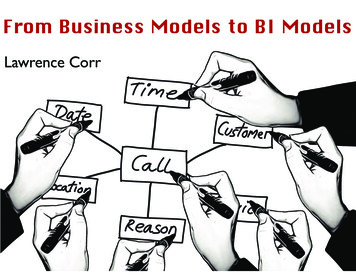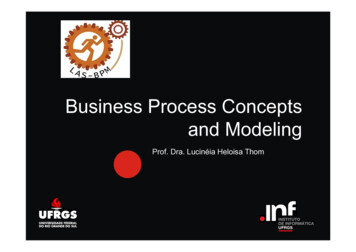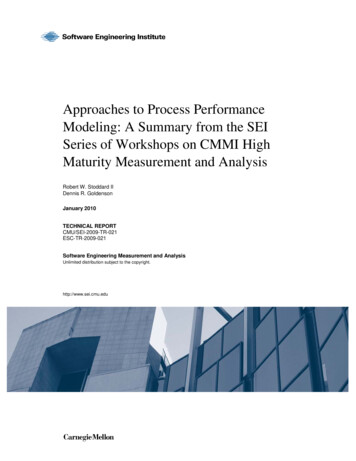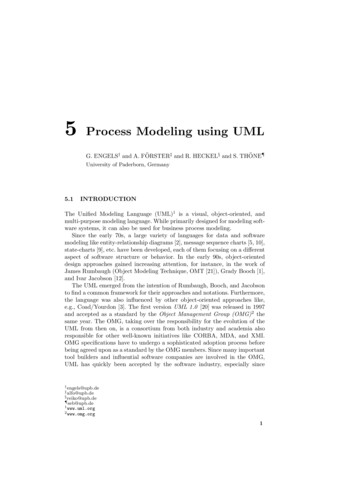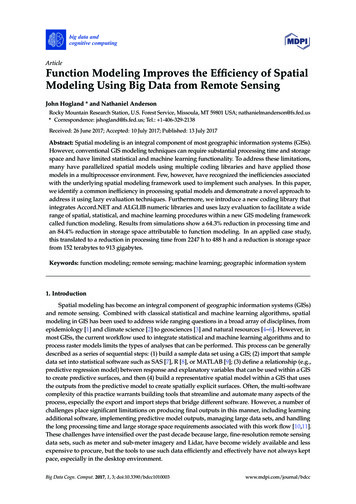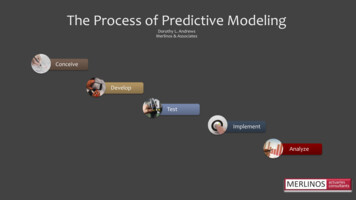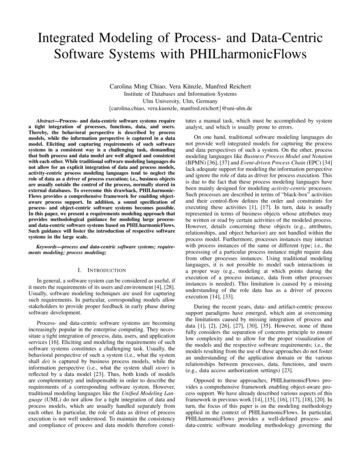
Transcription
Integrated Modeling of Process- and Data-CentricSoftware Systems with PHILharmonicFlowsCarolina Ming Chiao, Vera Künzle, Manfred ReichertInstitute of Databases and Information SystemsUlm University, Ulm, Germany{carolina.chiao, vera.kuenzle, manfred.reichert}@uni-ulm.deAbstract—Process- and data-centric software systems requirea tight integration of processes, functions, data, and users.Thereby, the behavioral perspective is described by processmodels, while the information perspective is captured in a datamodel. Eliciting and capturing requirements of such softwaresystems in a consistent way is a challenging task, demandingthat both process and data model are well aligned and consistentwith each other. While traditional software modeling languages donot allow for an explicit integration of data and process models,activity-centric process modeling languages tend to neglect therole of data as a driver of process execution; i.e., business objectsare usually outside the control of the process, normally stored inexternal databases. To overcome this drawback, PHILharmonicFlows provides a comprehensive framework for enabling objectaware process support. In addition, a sound specification ofprocess- and object-centric software systems becomes possible.In this paper, we present a requirements modeling approach thatprovides methodological guidance for modeling large processand data-centric software systems based on PHILharmonicFlows.Such guidance will foster the introduction of respective softwaresystems in the large scale.Keywords—process and data-centric software systems; requirements modeling; process modeling;I.I NTRODUCTIONIn general, a software system can be considered as useful, ifit meets the requirements of its users and environment [4], [28].Usually, software modeling techniques are used for capturingsuch requirements. In particular, corresponding models allowstakeholders to provide proper feedback in early phase duringsoftware development.Process- and data-centric software systems are becomingincreasingly popular in the enterprise computing. They necessitate a tight integration of process, data, users, and applicationservices [16]. Eliciting and modeling the requirements of suchsoftware systems constitutes a challenging task. Usually, thebehavioral perspective of such a system (i.e., what the systemshall do) is captured by business process models, while theinformation perspective (i.e., what the system shall store) isreflected by a data model [23]. Thus, both kinds of modelsare complementary and indispensable in order to describe therequirements of a corresponding software system. However,traditional modeling languages like the Unified Modeling Language (UML) do not allow for a tight integration of data andprocess models, which are usually handled separately fromeach other. In particular, the role of data as driver of processexecution is not well understood. To maintain the consistencyand compliance of process and data models therefore consti-tutes a manual task, which must be accomplished by systemanalyst, and which is usually prone to errors.On one hand, traditional software modeling languages donot provide well integrated models for capturing the processand data perspectives of such a system. On the other, processmodeling languages like Business Process Model and Notation(BPMN) [36], [37] and Event-driven Process Chain (EPC) [34]lack adequate support for modeling the information perspectiveand ignore the role of data as driver for process execution. Thisis due to the fact that these process modeling languages havebeen mainly designed for modeling activity-centric processes.Such processes are described in terms of “black-box” activitiesand their control-flow defines the order and constraints forexecuting these activities [1], [17]. In turn, data is usuallyrepresented in terms of business objects whose attributes maybe written or read by certain activities of the modeled process.However, details concerning these objects (e.g., attributes,relationships, and object behavior) are not handled within theprocess model. Furthermore, processes instances may interactwith process instances of the same or different type; i.e., theprocessing of a particular process instance might require datafrom other processes instances. Using traditional modelinglanguages, it is not possible to model such interactions ina proper way (e.g., modeling at which points during theexecution of a process instance, data from other processesinstances is needed). This limitation is caused by a missingunderstanding of the role data has as a driver of processexecution [14], [33].During the recent years, data- and artifact-centric processsupport paradigms have emerged, which aim at overcomingthe limitations caused by missing integration of process anddata [1], [2], [26], [27], [30], [35]. However, none of themfully considers the separation of concerns principle to ensurelow complexity and to allow for the proper visualization ofthe models and the respective software requirements; i.e., themodels resulting from the use of these approaches do not fosteran understanding of the application domain or the variousrelationships between processes, data, functions, and users(e.g., data access authorization settings) [23].Opposed to these approaches, PHILharmonicFlows provides a comprehensive framework enabling object-aware process support. We have already described various aspects of thisframework in previous work [14], [15], [16], [17], [18], [20]. Inturn, the focus of this paper is on the modeling methodologyapplied in the context of PHILharmonicFlows. In particular,PHILharmonicFlows provides a well-defined process- anddata-centric software modeling methodology governing the
object-centric specification of large process-oriented softwaresystems. Data and process models are still handled separately,to enable a proper understanding of the software requirementsin respect to the behavior and information perspectives ofthe software system. Furthermore, the process models arederived from the information perspective, which is coveredby the data model (i.e., data objects and their relations).Additionally, the behavioral perspective of the software systemis represented in two different levels of granularity: microand macro process types. A micro process type defines thebehavior of a particular object type; i.e., it defines how theprocessing of individual object instances of this type shallbe coordinated among process participants and how validattribute settings look like in this context. A macro processtype, in turn, defines how object instances interact with otherobjects instances; i.e., how the processing of inter-relatedobject instances (i.e., of their micro processes) shall be coordinated. Moreover, PHILharmonicFlows allows specifyingwhich users shall be authorized to access and manage processrelated data at defined points during process execution. Inthis paper, we present a requirements modeling approachthat provides methodological guidance for modeling processand data-centric software systems using PHILharmonicFlowsframework. In particular, such a methodology is indispensablefor the successful use of such a framework.Section II describes a case study and an example we usefor illustrating our modeling methodology. In Section III, wepresent the main characteristics of object-aware processes.The modeling methodology is described in Section IV. InSection V, we discuss how we validated this methodologyby applying it in different application domains. Further, wepresent a prototype as a proof-of-concept. Related work isdiscussed in Section VI. Finally, Section VII concludes witha summary and an outlook.II.C ASE S TUDYOur methodology has been applied in several applicationdomains (cf. Section V). As illustrating example, we use areal scenario from a Brazilian university we gathered in one ofour case studies. It comprises the project of a software systemthat manages extension course proposals (cf. Fig. 1). Extensioncourses are courses for professionals that aim to refresh andupdate their knowledge in a certain area of expertise. In orderto propose a new extension course, the course coordinatormust create a project describing it. The latter must then beapproved by the faculty coordinator as well as the extensioncourse committee.Illustrating Example (Extension course proposal): Thecreates an extension course projectusing a form. In this context, he must provide details about thecourse, like name, start date, duration, and description.Following this, professors may start creating the lecturesfor the extension course. In turn, each lecture must havedetailed study plan items, which describe the topics that willbe covered in the lecture.course coordinatorAfter creating the lectures, the coordinator may requestan approval of the extension course project. First, an approval must be provided by the faculty director. If hewants to reject the proposal, the extension course must nottake place. Otherwise, the project is sent to the extensioncourse committee, which will evaluate it. If there are morerejections than approvals, the extension course projectwill be rejected. Otherwise, it will be approved and hencemay take place in future.III.BACKGROUNDIn order to provide a better understanding on how oursoftware requirements modeling methodology emerged, wefirst introduce the main characteristics of object-aware processes. An intensive study concerning these characteristics hasshown that existing data-centric approaches do not cover allphases of the process life cycle of object-aware processes (formore details see [19], [32]). To overcome this drawback, wedeveloped the PHILharmonicFlows framework, which aimsat adequately supporting the fundamental characteristics ofobject-aware processes. Moreover, the framework provides awell-defined modeling methodology for large process- anddata-centric software systems, which will be presented in thesecond part of this section.The PHILharmonicFlows framework resulted from an intensive study analyzing various processes from different domains [14], [15], [19]. As result of this study, a set of propertieswas gathered, characterizing object- and process-awareness ininformation systems. Basically, for object-aware processes datamust be manageable in terms of object types. At runtime, thedifferent object types then may comprise varying numbers ofobject instances, whereby the concrete instance number mayhave to be restricted by lower and upper cardinality bounds.In the example from Fig. 2a, for each lecture, at least oneand at most five study plan items may be initiated.The modeling and execution of processes must be in accordance with the specified data model. In particular, processes arespecified at two different levels of granularity: object behaviorand object interactions.A. Object BehaviorTo cover the processing of individual object instances, thefirst level of process granularity refers to object behavior. Moreprecisely, for each object type a separate process definitionis provided. In turn, the latter is then used for coordinatingthe processing of individual object instances among differentusers. In addition, it is possible to determine in which order andby whom the attributes of a particular object instance must be(mandatorily) written, and what valid attribute settings (i.e.,attribute values) are. Consequently, at runtime, the creationof an object instance is directly coupled with the one of itscorresponding process instance. In this context, it is importantto ensure that mandatory data is provided during processexecution. Therefore, it must be possible to define objectbehavior in terms of data conditions rather than based onblack-box activities.B. Object InteractionsSince related object instances may be created or deletedat arbitrary points in time, a complex data structure emerges
Extension course projectCreative Writing01/04/2012English40 HoursThis course will focus on thedynamics of story creation.approved facultyInteresting course.FacultyCourse CoordinatorMax MeyerCreateextensioncourse projectCreate lectureProfessorLectureLectureCharacter Development10 HoursJohn SmithHow to develop acharacter in a fictionalstory.Mark MusterCreate lectureProfessorMaria mitteFig. 1.Committee MemberFrank FerdinandCommittee MemberSonja SunFacultyCreate studyplan itemCreate studyplan itemdata structureProfessorMaria MülleractivitiesusersCase Study and Illustrating ExampleDomain Data ModelaObject Instances – Data Structureextension course projectnamedescriptionattributesobject descriptionattributesrelationdecision committeeacceptancecommentcardinalitystudy plan itemdatedescriptionFig. 2.Approve extensionCommittee Membercourse projectPeter FrankApprove extensioncourse project01/04/2012Character Description101In this class, thestudents will be askedto create the basics ofa character.activitiesFaculty DirectorLola LeeExtension CourseCommitteeApprove extensioncourse projectStudy Plan ItemStudy Plan ItemusersFacultyApprove extensioncourse criptiondescription1.10Processes Instances – Process Structurecextension course projectnamedescriptionobjectobject ecommitteedecisioncommitteedecisionnamedecision plan ependencybetween n itemdatedatedescriptiondescriptionExample of Data Structure (a and b) and Process Structure (c)that dynamically evolves during runtime, depending on thetypes and number of created object instances (cf. Fig. 2c).Furthermore, individual object instances of same type maybe in different processing states at a certain point of time.The second level of process granularity we consider, therefore,comprises the interactions between related object instances ofsame and different types. A mechanism is required that allowscoordinating the execution of concurrently executed processinstances (each one related to a particular object instance).C. Data-driven ExecutionTo proceed with the processing of a particular object instance, in a given state, certain attribute values are mandatorilyrequired. Hence, object attribute values reflect the progressof the corresponding process instance (i.e., the processingstate of the respective object instance). More precisely, thesetting of certain object attribute values is enforced in orderto progress with the process through the use of mandatoryactivities. However, if the required data is already available,these activities may be automatically skipped when becomingactivated. Furthermore, to enable flexible process execution,users should be allowed to re-execute a particular activity, evenif all mandatory object attributes have been already set. For thispurpose, data-driven execution must be combined with explicituser commitments; i.e., users should be allowed to review andupdate the values that are set for the attributes of a particularactivity and to confirm the completion of the latter. Finally,the execution of a mandatory activity may depend on attributevalues of related object instances. Thus, the coordination ofmultiple process instances should be supported in a data-drivenmanner as well.
D. Variable Activity GranularityFor creating object instances and changing object attributevalues, form-based activities shall be used. Respective userforms comprise both input fields (e.g., text fields or checkboxes) for writing and data fields for reading selected attributesof object instances. However, note that different users mayprefer different work practices. As a consequence, dependingon the work style preferred, an activity may either be relatedto one or to multiple process instances; i.e., different workingstyles need to be enabled. Regarding instance-specific activities, for example, all input and data fields refer to attributes ofone particular object instance, whereas the forms of contextsensitive activities also comprise fields referring to different,but semantically related object instances (of potentially different type). For example, when editing attribute values related toa particular instance of object lecture, it might be favorableto also edit attribute values of the corresponding instancesof object study plan item. Finally, batch activities involveseveral object instances of the same type; i.e., the values ofdifferent input fields can be assigned to all involved objectinstances in one go.In addition to form-based implementation of activities, itmust be possible to integrate black-box activities as well. Thelatter might be required, for example, to enable complex computations as well as the integration of advanced functionalities(e.g., as provided by web services).IV.M ODELING S OFTWARE R EQUIREMENTS WITHPHIL HARMONIC F LOWS FRAMEWORKTo support information system engineers in developingobject- and process-centric software systems, this sectionpresents a well-defined modeling methodology that governsthe object-centric definition of processes at different levels ofgranularity. For this purpose, we differentiate between microand macro processes capturing both object behavior and objectinteractions. In detail, our modeling methodology comprisesthree major steps (cf. Fig. 3): stakeholders elicitation anddomain data modeling, behavior and functional requirementsmodeling, and rapid prototyping. Each of these steps is dividedinto one or more tasks, of which each produces artifactscovering different aspects of the software system.During process execution, PHILharmonicFlows automatically generates user forms, taking user authorization andprocess state into account; no manual efforts are required inthis context. Hence, with this approach it becomes more simplefor the system analyst to rapidly create prototypes duringsoftware development and to let the stakeholders test them andgive early feedback. The latter can then be used iterativelyto improve and refine the generated artifacts (i.e., softwaremodels) until the captured requirements reflect the needs ofthe stakeholders.A. Stakeholders Elicitation & Domain ModelingIn this first step, the information perspective is modeled.By creating a data model, domain objects are identified andmodeled through the definition of object types and theirrelations (including cardinalities). Using the same model, theorganizational entities are defined based on so-called usertypes. Overall, the data model constitutes the core artifactbased on which the processes describing the behavior andinteraction between objects are derived (i.e., micro and macroprocess types).1) Organizational Modeling: The organizational model isintegrated into the data model; i.e., user roles are consideredas object types as well. Each user role type is modeled as aspecific object type that is denoted as user type. The lattercomprises attributes, which can be used to characterize theuser role type, e.g., name, e-mail address, or, as in our casestudy, the faculty the user belongs to. In the example from Fig.4, the user types include course coordinator, professor, andcommittee member. To express that the course coordinator andprofessors belong to the same faculty, the instances of both usertypes must have attribute faculty filled with the same value. InPHILharmonicFlows, one user may possess more than one roleduring process execution. Finally, the relation between user anduser roles is defined during runtime.2) Domain Data Modeling: In the same data model comprising the user types, the object types describing the domainspecific data objects are added. Each object type comprises aset of attributes and may be related to other object types. Atruntime, these relations allow for a varying number of interrelated object instances whose processing must be coordinated.In particular, the data model is divided into data levels (cf.Fig. 4 for an example of a data model comprising three suchlevels). All object types not referring to any other object typeare placed at the top level (Level #1). Generally, an object typeis assigned to a lower data level as the object types it refers.1Additionally, cardinality constraints of the data model mightrestrict the minimum and maximum number of instances ofan object type that may refer to the same higher-level objectinstance. In our example (cf. Fig. 4), object types lectureand decision committee, for instance, refer to object typeextension course project. Both have cardinalities 1.n. Inturn, an instance of object type lecture may refer to maximum10 instances of object type study plan item.B. Behavior & Functional Requirements ModelingIn this second step, the behavioral perspective of thesoftware system is defined; i.e, what the system shall doand how this shall be accomplished is modeled in this step.Particularly, the process models produced in this contextcannot be handled apart from the information perspective (i.e.,data model). To enable object-aware processes (i.e., to definebusiness processes in tight integration with business data), theirmodeling must consider two levels of granularity (cf. Sect.III). More precisely, object behavior and object interactionsmust be captured in two different kinds of models. To describeobject behavior, we must specify a process definition for eachobject type. Such definition is called micro process type. Inturn, the interactions among multiple objects of the same ordifferent types are captured by a macro process type.The behavior of a single object (i.e., a micro process)is expressed by a number of possible states and transitions.Thereby, the progress of an object instance is driven bychanges of its attributes; i.e., a precise link between data andprocess state is established. In particular, whether or not a1 Note that this requires a special treatment of cyclic data objects. We referfor [16] for a respective discussion
StepTaskArtifactFormsRapidPrototypingUser andRole TypesAutomaticGeneration Information PHILharmonicFlowFlowsModelingBehavior& ion& Domain DataModelingDomain DataModelingBehaviorModelingMacroProcess TypeData Objectand RelationsMicro ProcessTypesFig. 3.Modeling MethodologyOrganization and Domain Model (Data Model)OTextension course projectnameattributesdescriptionobject namefaculty1.nOT decision mecommittee#1user g. 4.study plan itemdatedescriptiondata level#3Example of a Data Modelparticular state is reached during runtime depends on the valuesof object instance attributes. In turn, the interactions amongobjects instances become enabled when involved objects reachcertain states. Consequently, object states serve as an abstractinterface between micro and macro processes.1) Behavior Modeling: When referring to behavior modeling, not only the behavior of a single object type is described,but also the interactions among different objects instances ofthe same or different types. Two different artifacts result fromthis: micro process types describing the behavior of involvedobject types on one hand, and a macro process type describingthe interactions among objects of the same or different typeson the other.In PHILharmonicFlows, for each object type defined inthe the data model, a specific micro process type must bedefined. At runtime, both object instances of the same andof different object types may be created at different pointsin time. In particular, the creation of a new object instance isdirectly coupled with the one of a corresponding micro processinstance. The resulting micro process type then coordinates theprocessing of an object among different users and specifieswhat valid attribute settings are.Each micro process type comprises a number of microstep types, which describe elementary actions for reading andwriting object attribute values. More precisely, each microstep type is associated with one particular attribute of therespective object type. In turn, micro step types may be linkedusing micro transition types. To coordinate the processing ofindividual object instances among different users, micro step
types need to be grouped into state types; i.e., each statepostulates specific attribute values to be set. Such state typesare associated with one or more user roles. During runtime,each association between a user role and a state type isrepresented as a mandatory activity (i.e., a work item in thework list of the respective user). Such activities are form-based,where each field of the form corresponds to an attribute (i.e.,micro step type) associated to the correspondent state type.At runtime, a micro step may be reached (i.e., completed)if for the corresponding attribute a value is set. In turn, astate may be left (i.e., the next state be activated) if values forall attributes associated with the micro steps of this state areset. Whether or not the subsequent state in the micro processis immediately activated, however, then also depends on userdecisions; i.e., process execution may be both data- and userdriven [32]. To enable user involvement, micro transition typesconnecting micro step types of different state types may becategorized either as implicit or explicit. Using implicit microtransitions, the target state will be automatically activated assoon as all attribute values required by the previous state become available. In turn, explicit micro transitions additionallyrequire a user commitment before activating the next state; i.e.,users may decide whether or not the subsequent state shall beactivated. This way, users are enabled to still change attributevalues corresponding to a particular state even if all of themimplicitly have been already set.An example of a micro process type is depicted in Figure5a. A corresponding micro process instance is initiated instate under creation, for which values of the attributes name,start date, faculty, credits, and description must beset. Regarding state under approval faculty, for example,a user decision is modeled, which is related to micro steptype decision faculty. At runtime, a user associated with therole faculty director must then decide whether to rejector approve the extension course project. Finally, the givenmicro process type has two end state types: rejected andapproved. Which of these two states becomes activated atruntime and hence will terminate the processing of the objectinstance depends on the decision made in the context of microstep decision faculty (i.e., the value of set for attributedecision faculty).In general, whether or not subsequent states may bereached also depends on the processing states of other microprocess instances. At runtime, for each object instance a corresponding micro process instance exists. As a consequence,a characteristic process scenario may comprise hundreds ofmicro process instances. Taking their various interdependencies into account, we obtain a complex and large processstructure. In order to coordinate the interactions between thedifferent micro process instances of such process structure, acoordination mechanism is established that allows specifyingthe interaction points of the micro processes. More precisely,the system analyst must specify at which points during processexecution a particular micro process instance needs input fromother micro process instances of same or different type (cf.Fig. 6a). In turn, these interaction points can be modeled for amacro process type (cf. Fig.6b). Such a macro process typerefers to parts of the data structure and consists of macrosteps types as well as macro transitions types linking them.As opposed to traditional process modeling approaches, whereprocess steps are defined in terms of activities, a macro steptype always refers to an object type and a corresponding statetype.The macro process type corresponding to our example isillustrated in Figure 6b. The macro process begins with creating an instance of object type Extension Course Project.In turn, this triggers the execution of a corresponding microprocess instance. Following this, a varying number of instancesof micro processes corresponding to instances of object typeLecture are created. For each instance of object type Lecture,an arbitrary number of instances of Study Plan Item may becreated as well. When all instances of Study Plan Item reachstate finished, the corresponding instance of Lecture may befinished as well.Since the activation of a particular micro process state maydepend on instances of other micro process types, macro inputtypes are assigned to macro step types. The latter may thenbe associated with several macro transitions. To differentiatebetween AND and OR semantics in this context, it is furtherpossible to model more than one macro input for a macro steptype. At runtime, a macro step will become enabled if at leastone of its macro inputs is activated. In turn, a macro input willbe enabled if all incoming macro transitions are triggered.Information Flow ModelingRegarding information flows, we must specify how theobject instances shall be coordinated among the system users;i.e., which users shall be able to read and write which objectattributes at which point during the execution of the respectiveinstance. The artifact to be created for this purpose documentsthe authorization settings for each micro process type.At the micro process level, the state types, which contain anu
that both process and data model are well aligned and consistent with each other. While traditional software modeling languages do not allow for an explicit integration of data and process models, activity-centric process modeling languages tend to neglect the role of data as a driver of process execution; i.e., business objects


